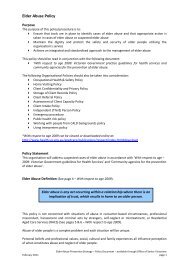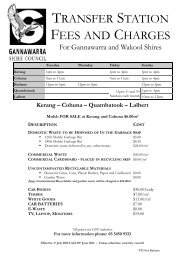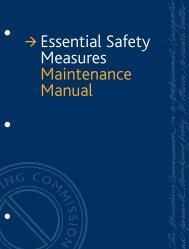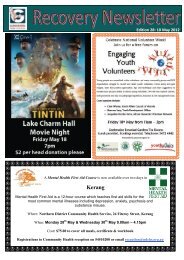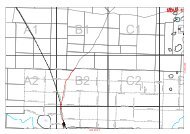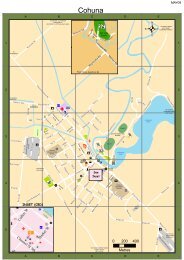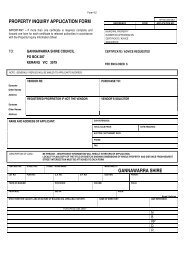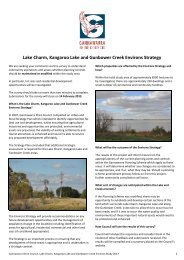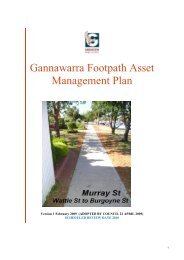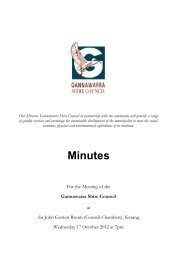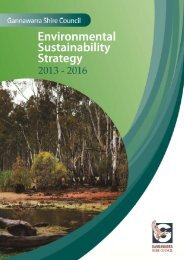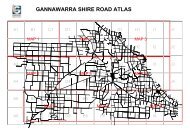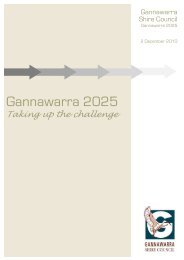Southern Loddon Mallee Regional Strategic Plan 1 - Macedon ...
Southern Loddon Mallee Regional Strategic Plan 1 - Macedon ...
Southern Loddon Mallee Regional Strategic Plan 1 - Macedon ...
You also want an ePaper? Increase the reach of your titles
YUMPU automatically turns print PDFs into web optimized ePapers that Google loves.
MaNage OuR POPuLaTION gROwTh aND SeTTLeMeNTS<br />
Liveability<br />
The forces of growth have the potential to overwhelm the lifestyleliveability<br />
assets of our region, that are driving the growth in the<br />
first place. Critical choices need to be made about the shape and<br />
form of urban development, about the links between places, and<br />
about the type of urban development that will support sustainable<br />
water provision and transport systems.<br />
The majority of new urban development will need to be contained<br />
within existing towns and settlements or designated growth areas<br />
with good access to services, education, employment, transport<br />
and social networks.<br />
Transport and employment planning are critical to determining<br />
the future capacity of growth settlements. We must also protect<br />
water catchment areas, land with high environmental or amenity<br />
value and to ensure non-urban breaks between settlements are<br />
maintained.<br />
Rural living<br />
Rural living is an attraction of the region. There is a continuing<br />
tension between the protection of viable farming land and the<br />
demand for smaller rural allotments. Set against the general trend<br />
of consolidation of farming landholders, there are also a variety of<br />
opportunities to more intensively develop rural land for the equine<br />
industry, boutique wineries, and orchards.<br />
Our land use has historically been dominated by dryland and<br />
irrigated agriculture. Almost all of our irrigated agriculture is<br />
located in <strong>Loddon</strong> Shire, although pockets of irrigated horticulture<br />
or viticulture are distributed through the region. The main dryland<br />
agricultural land uses are livestock grazing and cropping.<br />
Priority actions:<br />
1.1<br />
Although much of the land to the south and east of Bendigo is<br />
classified as being used for agriculture, limited commercial-scale<br />
agriculture occurs and land is often valued for its amenity for<br />
rural living, rather than its potential for agricultural production.<br />
Settlement planning must ensure that the development in these<br />
areas does not generate demand for unsustainable expansion to<br />
services or infrastructure.<br />
Housing choices<br />
Identification of regional housing needs in light of projected<br />
population growth, changing household composition and<br />
needs may be best coordinated at a regional level. <strong>Plan</strong>ning for<br />
an increased supply of housing which maintains the character<br />
of existing towns, minimises impacts on natural environments<br />
and responds to bushfire risk is an ongoing challenge for our<br />
region. This challenge is likely to intensify over time as population<br />
growth and development pressures increase. The proportion of<br />
households with one or two people will continue to increase and<br />
may stimulate demand for smaller dwelling units.<br />
Forward planning for projected population and economic growth<br />
requires new investment in energy and waste infrastructure.<br />
Actions proposed focus on planning for regional approaches to<br />
waste reduction and recycling and assessing alternative energy<br />
sources. Additional investment to progress and service industrial<br />
land will also be essential to meet industry demand.<br />
Establish a <strong>Regional</strong> Settlement Framework that respects the amenity, functionality and connectedness of existing<br />
cities and towns, and accommodates growth accordingly.<br />
Key initiatives:<br />
1.2<br />
Support population stability and interventions to encourage growth in areas where population has stabilised or<br />
fallen (e.g. <strong>Loddon</strong> and Central Goldfields Shires).<br />
3<br />
1.3<br />
Undertake strategic work and implement appropriate rural zones across the region to manage land use and<br />
support existing and emerging rural based activities.<br />
3<br />
1.4 Link planning with natural resource protection and water demand and provision. 3<br />
1.5<br />
Fund a pilot project to showcase higher density, mixed use, sustainable development on Government or private<br />
land within Bendigo which includes affordable housing.<br />
3<br />
1.6 Develop targeted aged, emergency and social housing across the region. 3<br />
1.7<br />
Implement relevant findings of the Bushfire Royal Commission and support Integrated Fire Management <strong>Plan</strong>ning<br />
through the development of the <strong>Regional</strong> <strong>Strategic</strong> and 10 Municipal Fire Management <strong>Plan</strong>s.<br />
3<br />
1.8<br />
Implement the Calder <strong>Regional</strong> Waste Management <strong>Plan</strong> with a focus on increasing community education about<br />
waste issues including waste reduction and recycling.<br />
3<br />
Horizon (years)<br />
1-5 >5<br />
<strong>Southern</strong> <strong>Loddon</strong> <strong>Mallee</strong> <strong>Regional</strong> <strong>Strategic</strong> <strong>Plan</strong> 15<br />
3<br />
Horizon (years)<br />
1-5 >5



